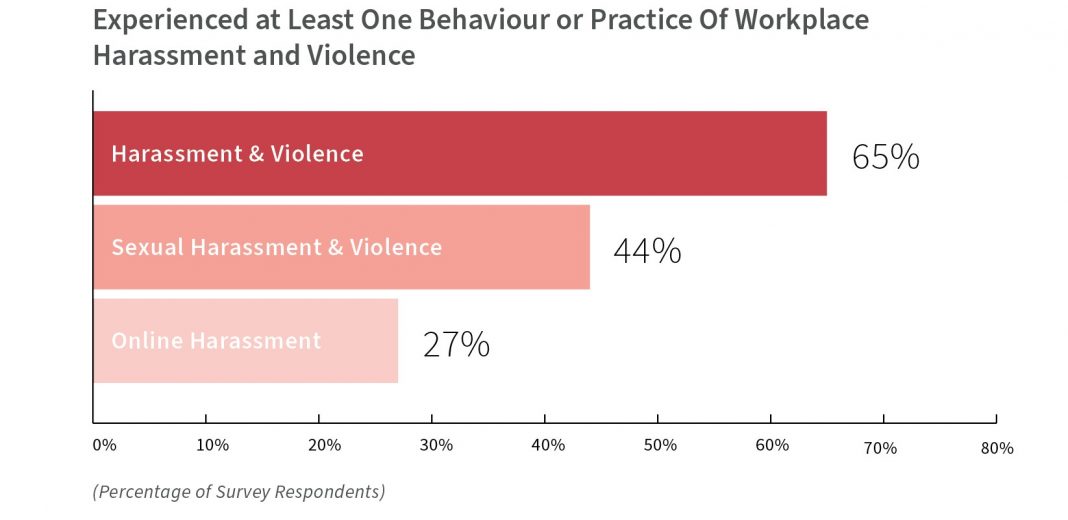Dr. Adriana Berlingieri, Research Associate and Barb MacQuarrie, Community Director at the Centre for Research & Education on Violence Against Women & Children in Canada, discuss the prevalence and impact of harassment and violence in the workplace
In Canada, every jurisdiction, including the federal level, ten provinces, and three territories, has enacted legislation to address harassment and violence at work. These laws are dynamic, reflecting ongoing efforts to ensure a safe working environment free from harassment and violence for all employees.
How is Canada protecting workers?
There is a growing focus on preventing and addressing gender-based harassment and violence at work, with many jurisdictions now explicitly covering sexual harassment and domestic violence. For instance, the Canada Labour Code requires federal employers to proactively prevent sexual harassment, and Ontario’s OHSA, revised in 2016, specifically defines workplace sexual harassment. While most, but not all, jurisdictions have explicit legislation for domestic violence or family violence in the workplace, related resources and interpretive guidelines also address these behaviours.
Yet, our research clearly shows that harassment and violence remain pervasive and destructive problems in contemporary Canadian workplaces. Our 2022 report, Harassment and Violence in Canadian Workplaces: It’s [Not] Part of the Job, captured what is happening across the country just as the Work Place Harassment and Violence Prevention Regulations brought about amendments to the Canada Labour Code to strengthen the previously existing framework for harassment and violence prevention in federally regulated workplaces.
The report relied on data from an online survey, with a response count of 4,878. Most respondents (86%) were in permanent employment, while temporary and other forms of employment contracts accounted for 14%. The respondents were predominantly union members (87.8%), a figure substantially higher than the general Canadian workforce (31.3%). This demographic skew suggests the survey may highlight insights from workers with greater workplace health and safety protections. Respondents spanned various industries and provinces, with the largest representations in education (23.3%), healthcare and social assistance (20.1%), and public administration (17.1%), and the highest regional responses from Ontario, British Columbia, and Alberta.
Most participants were 30-59 years old, with an underrepresentation of potentially more harassment-prone younger women. Women comprised 75% of respondents, with men at 23% and gender-diverse individuals at 2%. Additionally, 13% identified as LGBTQ2S+, 26% reported disabilities, and 85% were Canadian-born. While most identified as White (82.7%), there was less participation from racialized and Indigenous people compared to their workforce percentages, which could affect the representativeness of the survey results. Additionally, researchers conducted 34 interviews with participants who represented various ethnicities, sexual orientations, gender identities, religions, income levels, industries, and geographical locations.
What did the findings reveal?
- Almost three-quarters (71.4%) of survey respondents experienced at least one form of harassment and violence, or sexual harassment and violence, in the two years prior to completing the survey;
- Almost two in three (65%) of survey respondents experienced at least one behaviour or practice of harassment and violence at work in the past two years;
- Just over two in five (43.9%) of survey respondents experienced at least one behaviour or practice of sexual harassment and violence in the past two years while at work; and
- Just over one-quarter (26.5%) of respondents surveyed experienced at least one form of work-related online harassment in the past two years.
Experiences are not the same for everyone. Workers who face multiple and intersecting forms of discrimination – whether by race, gender, sexual orientation, gender identity and expression, disability, or Indigeneity – experienced different prevalence rates.
Gender-diverse individuals are more likely to report experiencing all forms of harassment and violence. This was most pronounced for sexual harassment and violence: 73% of gender-diverse respondents experienced this form of harassment and violence compared to 46% of women and 38% of men.
LGBTQ2S+ respondents were also particularly likely to have experienced all forms of harassment and violence. This is most pronounced for harassment and violence (72%) and sexual harassment and violence (62%).
Indigenous respondents experienced significantly higher rates of harassment and violence (79%) and sexual harassment and violence (47.8%).
Survey respondents living with at least one form of disability experienced significantly higher rates of all forms of harassment and violence at work.
Over three-quarters (76%) of these respondents experienced at least one behaviour or practice of harassment and violence compared to 60% of those who did not report a disability. Over half (55%) of the respondents living with a disability experienced at least one behaviour or practice of sexual harassment and violence compared to 40% of those who did not indicate living with a disability. The same pattern appears with regard to online harassment. Over one in three (35%) of respondents living with at least one disability experienced at least one behaviour or practice of this form of harassment (compared to 23% of those who did not indicate a disability).
Eradicating violence and harassment at work
Canada formalized its commitment to enhancing workplace safety by ratifying the International Labour Organization’s Violence and Harassment Convention (No. 190) on January 30, 2023. To align with the treaty’s objectives to eradicate violence and harassment at work, Canada must now review its current legislation to pinpoint discrepancies with the convention’s guidelines. This review may lead to legislative revisions or the introduction of new laws. This process will involve thorough consultations with key stakeholders, such as employers, labor unions, and advocates for workers’ rights. The insights garnered from this analysis, and additional research anticipated in 2025 will illuminate the areas most in need of improvement.
The consequences of harassment and violence for workers, workplaces, and governments are profound and costly, ranging from severe physical and mental health consequences, lost earnings, and destroyed career paths to profound economic losses for workplaces. We cannot afford not to do this work.

This work is licensed under Creative Commons Attribution-NonCommercial-NoDerivatives 4.0 International.


